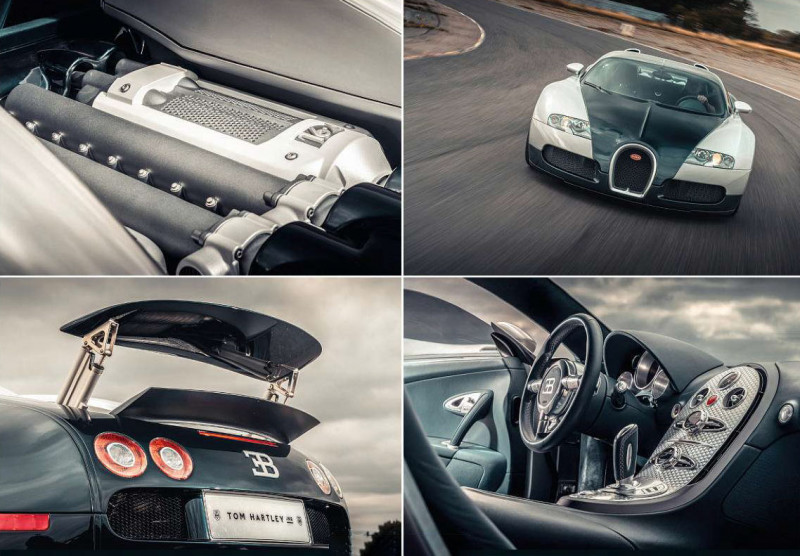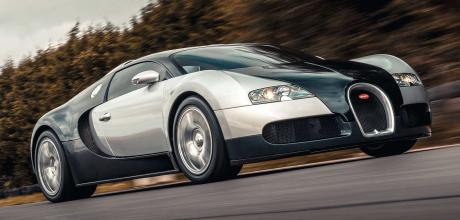2005 Bugatti Veyron 16.4
‘It would take a tough cynic to deny that bringing the Veyron to market did justice to marque legends Ettore and Jean Bugatti
No production car had ever been conceived from such an unreasonable brief as the 2005 Bugatti Veyron 16.4. It was as if Ferdinand Piëch, the Volkswagen Group’s big chief and the person responsible for the Bugatti brand’s 1998 rebirth, had plucked the target numbers out of thin air, like a child might if they were asked to create a fantasy mega-car: 1000 horsepower, a top speed in excess of 250mph, and a price-tag of €1 million. Pretty please. The plan faltered almost immediately. After revealing the concept at the 1999 Tokyo motorshow, complete with a never-to-be-used W18 engine, Bugatti’s fledgling engineering team struggled to bring the key elements together. But in 2003, a new engineering head, DrWolfgang Schreiber, was appointed, quickly followed by new president Thomas Bscher. Almost every aspect of the project was revisited,and by 2005, with an incredible 95% of the car’scomponents re-engineered, the first Veyronrolled out of Bugatti’s Molsheim works.
However sceptical you were about Volkswagen’s purchase of the historic Bugatti name, it would take a tough cynic to deny that bringing the Veyron to market did justice to marque founder Ettore Bugatti and son Jean, true innovators in their own right and producers of fine automobiles and race cars. The Veyron really was a technical tour de force like no other. Now with a W16 engine, it not only produced the requisite 1000hp (actually, 1001PS, or 987bhp), but an eyewatering 922lb ft of torque, which all resulted in an official 253mph.
The car’s development had been tortuous. A total of 10 radiators had to be used to cool the 8-litre engine, which was left without a cover to release still more heat. In order to deploy all that power, an all-wheel-drive system was created, with a complex Haldex differential working on the front axle and a limited-slip differential at the rear. A seven-speed dual-clutch automatic gearbox was used, with shift times of just 150 milliseconds. And the job of hauling nearly two tonnes of Veyron from 250mph to standstill needed carbon-ceramic discs that measured a colossal 15.7in (400mm) in diameter.
But it was the Veyron’s W16 engine that gave it the muscle to out-pin the previous decade’s McLaren F1 for maximum velocity. Created by joining the cylinder banks from two of VW’s narrow-angled VR8 engines on to a single crankshaft (and hence, almost, a ‘W’ shape), a pair of camshafts operated the 32 valves on each eight-cylinder bank. The engine was square, with each of its 86mm x 86mm cylinders displacing 499.56cc. Four turbochargers (two per bank) pumped air at 18psi via a pair of charge-cooling liquid-to-air intercoolers, complete with three heat exchangers. Or, put another way, it was the most extravagant production engine in the world at launch – and the thirstiest: it would take just 20 minutes to empty the Veyron’s 100-litre tank of high-octane fuel at full chat.
Having never sat in a Veyron before today, my preconceptions are of a one-dimensional hypercar built for nothing more than achieving 250mph-plus. That it is nothing of the sort pleases me greatly. I’m still not a fan of the Veyron’s styling, but when you wonder at the packaging, cooling and aerodynamic challenges faced by Bugatti, it’s remarkable how easy on the eye it actually is. Step through the driver’s door into the exquisitely trimmed cabin and what strikes you is how conventional and simple all the controls are. I wasn’t expecting a 747’s flight deck, but all that faces you is a small binnacle containing five dials and next to it a machine-turned aluminium console with the climate controls. Lower down sits the shift lever for the dual-clutch ’box. There’s little else.
I’m not given the ‘magic’ key that permits access to 213mph-plus bedlam, but Jonty Collier from Tom Hartley Jnr, which kindly lent us this Veyron, is not precious about us exploring its potential below that speed. And I can see why. Push the start button, select drive, accelerate away at a normal rate and you could be driving a slightly larger Golf. Try a little harder and, incredibly, it’s like a very refined, grown-up Esprit: agile, communicative and responsive during cornering. I drive two laps and comment to Collier that it’s fast but not that fast. He says I need to try harder and wake all four turbos, so I do, and it does. Speed is always relative, but 40 years of driving some very quick machinery hasn’t prepared me for this. From inside, the four-blown W16 sounds like that aforementioned 747 on full thrust. After some initial lag, the Veyron’s 4162lb heft is no match for the monstrous torque, and as we head towards turn one at Prestwold, the speed it reaches is near suicidal. Thankfully the brakes, helped by the air brake you see springing up in the mirror, are equally stupefying, and we get to live another day.
Well, if not another day, then at least long enough to get a chance to try the Chiron.
Thanks to Tom Hartley Jnr (tomhartleyjnr.com)
FASTEST FORMULA ONE CAR
246.9mph
F1 cars are designed for cornering speeds and acceleration, not top speed. But in 2006, Honda’s F1 team took its ex-Jenson Button/ Takuma Sato racer to the Bonneville Salt Flats to see what it would do. Fitted with an unrestricted V10 engine and a stability fin instead of a rear wing, it managed 246.9mph, driven by Alan van der Merwe, the team’s test driver
TECHNICAL DATA FILE 2005 Bugatti Veyron 16.4
- Sold/number built 2005-’2011/252
- Engine all-alloy, dohc-per-bank 7993cc W16, with four turbochargers and electronic fuel injection
- Max power 987bhp @ 4200rpm
- Max torque 922lb ft @ 2200rpm
- Transmission seven-speed dual-clutch automatic, all-wheel drive
- Suspension independent, by double wishbones, self-damping hydraulics
- Steering rack and pinion
- Brakes carbon-ceramic discs, with servo and anti-lock
- Weight 4162lb (1888kg)
- 0-60mph 2.5 secs
- Top speed 253mph
- Price new £925,000
- Price now £850,000-1.5m

Clockwise: the Veyron is oddly normal to drive, until the turbos kick in; simple but glitzy cockpit; air brake aids retardation; engine makes 987bhp


